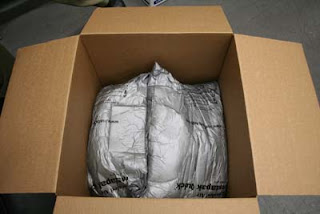 |
| Items packed onto 40x48 pallet to be shipped via freight. |
 |
| Shrink wrapped and banded pallet - ready to ship! |
Freight shipping is a great option if your item(s) weigh more than 150
lbs., which is too heavy for a parcel service to transport. You may need to
ship one large, heavy item (a chest, a chair) or maybe you’re shipping many
items that have a combined weight of more than 150 lbs. (boxes, small
furniture).
In both cases, the items should be packaged carefully and then shrink
wrapped and banded onto a standard 40x48 pallet. This secures the items
together to the base, which is then moved onto a truck by forklift or pallet
jack. If your shipment contains many boxes, this is a great way to ship them
all together in one snug group, rather than separately with a parcel service –
there is less chance for damage or loss, and everything arrives at the same
time.
For small household moves,
it may be less expensive to ship your items via freight than with a traditional
household move (if you have less than a truckload (LTL)). Shipping costs are
based on weight and dimensions, so after your items are banded to a pallet, it
can be weighed and measured, and an accurate quote can be ascertained.
Freight shipments primarily deliver to the curb. Any extra services
required at destination, such as indoor delivery, lift-gate service, or specific
day/time delivery, will incur extra fees for each accessorial service. A failed
delivery attempt will also cause an extra fee.
In order to register a freight shipment, there is specific information
needed in order to ensure proper delivery:
1.
shipper and recipient’s name, address, phone
number, email address
2.
Does the recipient require lift-gate service or
is there a dock at destination?
3.
Does the recipient require indoor delivery?
4.
Can the destination address safety receive a
tractor-trailer delivery?
Insurance valuation is an important option to think about
when shipping via freight. Generally, insurance valuation for regular household
goods shipments is $.50 per $100, but you must check this with your freight
carrier when scheduling.

















